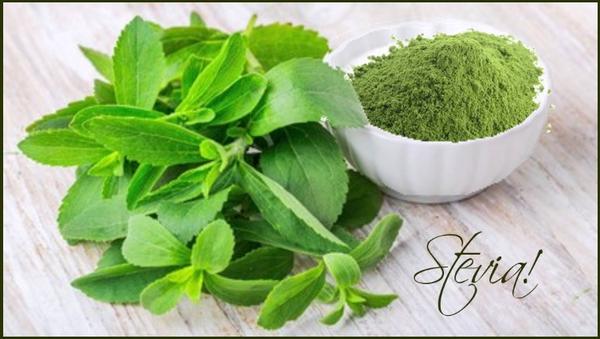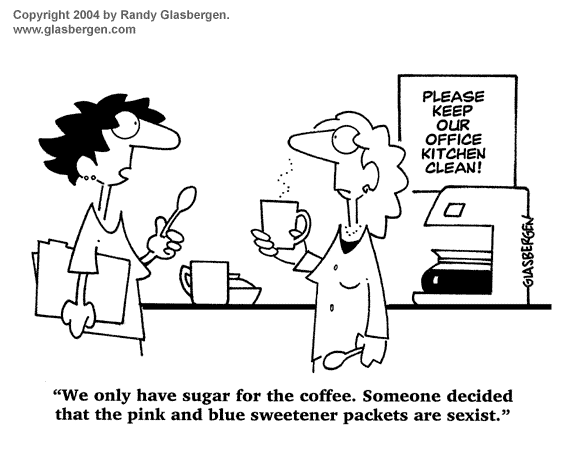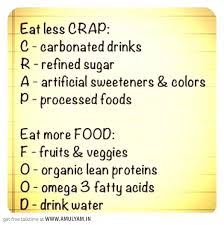Stevia: Is it as ‘natural’ as you think?
By Susan Burke March
The stevia plant is a perennial that does best in sunny, warm climates with plenty of rain. In the battle of commercial sweeteners, consumers who want to enjoy the taste of sweet without calories and without artificial ingredients have increasingly turned to packaged stevia powders and extracts.
Here are some facts about stevia and its use in the marketplace today (Global Stevia Institute):
- Indigenous South Americans were first to use stevia as a sweetener, chewing the leaves for the sweet taste. They also used leaves to sweeten beverages.
- It wasn’t until 1905 that scientists defined the plant as ‘stevia rebaudiana’ and classified it as a member of the sunflower family, related to the Chrysanthemum.
- In 1931 chemists isolated the sweet-tasting compounds called steviol glycosides.
- Processing the leaves into a powder or liquid sweetener creates a no-calorie extract 200-300 times sweeter than sugar (sucrose).
- Japan was the first nation to approve stevia sweetener for commercial use in 1971, and remains number one in use.
- In 1984 China began cultivating stevia plants, and remains the number one producer. All the big commercial producers source their stevia from China.
- In 2008, the U.S. FDA approved stevia extract as “GRAS” or generally recognized as safe to use in foods and beverages; in 2011 the European Food Safety Authority approved steviol glycosides as a sweetener in foods and beverages.

Quick quiz: How much do you know about natural sweeteners?
- Which of the following sweeteners is “natural”? (Defined by the Cambridge English Dictionary as “not artificial or involving anything made or caused by people”.)
- Agave nectar
- ‘Sugar in the Raw
- Erythritol
- Honey
Answer: Honey. Raw, unpasteurized honey contains micronutrients removed from pasteurized honey (as well as pollen and even small insect parts). Avoid giving honey — even a tiny taste — to babies under the age of one (Mayoclinic.org). Agave ‘nectar’ is produced from the starch of the root bulb of the yucca or agave plant. Using an enzymatic and chemical process, the starch is converted into fructose-rich syrup, similar to the way that cornstarch is converted into high fructose corn syrup (HFCS). Interestingly, agave nectar is very high in fructose – it’s 70 percent fructose or higher, while HFCS is only 55 percent fructose. Erythritol occurs naturally in some fruit and fermented foods, but for commercial use it’s produced from glucose by fermentation with yeast. ‘Sugar in the Raw’ is turbano sugar — which is what’s left over after raw sugar cane juice has been processed and stripped of its natural molasses and impurities, as well as its vitamins, minerals and other trace elements (Time).
2. Cargill, the global agricultural commodity business, jointly with Coca-Cola has patented the extracting process to create a stevia extract called:
- Rebaudioside A
- Rebaudioside C
- Steviol
- Steviolbioside
Answer: Rebaudioside A
Rebiana is the trade name for the steviol glycoside Rebaudioside A. Coca-Cola also produces a soft drink with rebiana called ‘Coke Life.’ According to the UK’s Daily Mail, health experts have accused Coca-Cola of ‘health washing’ the message to convince consumers that Coke Life is ‘healthier’ than Diet Coke or Coke Zero Sugar. However, don’t be fooled by the front of the label marketing. Coke Life contains the full amount of an adult’s recommended daily allowance of sugar in just one 330 ml can (about 11 ounces). A can of regular Coke has 35g of sugar, equivalent of almost 10 teaspoons of sugar and 139 calories: Coke Life still has 22g of sugar, equivalent of six teaspoons and 89 calories (about 35 percent less sugar compared to the regular). The World Health Organization (WHO) recommends that adults of normal body mass index only eat 25g of sugar in total per day.
- Which of the following products were named in class-action lawsuits that were settled in favor of the plaintiffs for $6.1 million?
- Stevia Life
- Stevia in the Raw
- Sweet Leaf
- Truvía
Answer: Truvía. In 2014, Cargill settled a class-action lawsuit grounded in false and misleading advertising for $6.1 million. The suits claimed that Cargill was deceptive in its marketing of Truvia as a “natural” sweetener. There’s little that’s natural about the product. As reported on the blog Fooducate, “To get from a stevia leaf to Reb A, a long chemical process is employed” using a myriad of chemicals, some highly industrial. Only 5% of Truvía is stevia and the rest is erythritol, a bulking agent, and “natural flavors”, which are undefined. Erythritol is processed from corn and in the USA only 12% of corn is non-GMO, so despite the website’s claim that there are no GMO ingredients, and since it’s not certified organic by the USDA…well, you can read more for yourself here.
4. True or False: When you see the word “natural” on the front of a food or cosmetic package you can be assured that all of the ingredients come from nature.
Answer: False. “Natural foods” and “all natural foods” are widely used terms in food labeling and marketing with a variety of definitions, most of which are vague. The term is often assumed to imply foods that, as reported in Wikipedia, “are minimally processed and whose ingredients are all natural products (in the chemist’s sense of that term), thus conveying an appeal to nature. But the lack of standards in most jurisdictions means that the term assures nothing. In some countries, the term “natural” is defined and enforced. In others, such as the United States, it is not enforced.”
Stevia’s green leaves (when raw and unprocessed) taste strongly of licorice — and I think even when leaves are dried and powdered the “natural” stevia tastes like licorice. But the white stevia powders and liquid extracts we buy in the natural foods and grocery stores are highly refined chemical extractions and have little to none of that distinctive flavor. Many of the products are packaged with fillers, bulking agents and additional sweeteners such as dextrose (a form of sugar) to “balance” the taste. However, there is some commercial stevia that is better than others.
 “Natural” Stevia, and the rest.
“Natural” Stevia, and the rest.
I went to Supermaxi to do a little stevia sleuthing. While many varieties carry the “natural” proclamation on the front of the package, I’m not a believer in front-of-the-package claims. Just flip the package over and find the ingredient list. As always, ingredients are listed in descending order of weight or volume. That means the ingredient listed first is the primary ingredient, followed by lesser ingredients. Unfortunately, we’re not privy to the ratios.
The “Natural”
Whole leaf stevia. The stevia plant is easy to grow and they’re sold in mercados and nurseries around Cuenca. So are dried stevia leaves.
Dried stevia leaves are also sold in a nice little plastic pouch in Supermaxi! Of course, they’re located all the way on the bottom shelf…you’ll have to squat way down to find them. Ingredient list? Stevia leaves. One ingredient. Producto de la Amazonía Ecuatoriana.
For additional sources, I reached out to my Facebook friends — one friend says he bought a stevia plant at the weekend market located on Max Uhle, across from the electric company.
What to do with the real thing? Taylor says she buys the dried leaves in the mercado, steeps them in vodka for 24 hours, boils off the alcohol, and puts it into a dropper bottle for sweetening tea and other drinks. She says this way it’s not bitter at all. Larry posted a link to a video that shows you how to make your own pure stevia and liquid stevia.

Stevia sleuthing in Supermaxi
The Rest
Listed in order of acceptability. This is my opinion, and please feel free to post your own preferred brands or recipes for making your own stevia sweeteners in the comments below.
Stevia Life: The front of the box states “Dulzura 100% Natural” which I believe translates to “100% natural sweetness.” Hmmm. The first ingredient listed is “Sólidos de Maíz” so, like most of the store’s powdered stevias, the first ingredient is a filler, in this case, “corn solids” or corn syrup solids. Dried corn syrup is treated with enzymes and acids. The second ingredient is stevia extract. This blend has no “natural flavors.”
Truvía: The first ingredient in Truvía is erythritol, a sugar alcohol derived from corn, however, their webpage prominently displays “stevia leaf extract” as the primary ingredient. Well, I can read. It also contains “natural flavors” without identifying them.
Pure Via: Not to be outdone by Truvía, Pure Via also settled a similar lawsuit for false advertising for $1.65 million. They state that this sweetener is not “all natural” but is made to their own “natural standard.” Terms of the settlement including revising their marketing and labeling to invite consumers to learn more about their unique manufacturing process. This product’s first ingredient is dextrose, a filler made from corn sugar, fruits or honey. I’ve written to the company to find the source of the dextrose since it’s typically manufactured from corn, but I have not received an answer. Pure Via also markets “blends” containing real sugar — people who are counting on a calorie/carbohydrate–free sweetener need to account for the carbs.
Stevia Sweet: Endulzante Liquido: This liquid sweetener has a picture of a hummingbird hovering over a flower, as if by purchasing this product you’d be getting nectar from nature. The label also says, “Endulzante con Stevia de origen natural”…OK, you know the drill. Flip it over and read the ingredients. Agua purificada, glicerina, stevia extracto seco, acido citrico, citrate de sodio, sorbato de potasio, benzoate de sodio. After the third ingredient (stevia extract), the rest of the ingredients are preservatives. As for glycerine, this is typically vegetable glycerin, a sweet substance derived from palm or coconut oils and used as a carrier in liquids. I haven’t seen any health negatives associated with consuming it.
Stevia Sweet: Endulzante en Polvo: The powdered version, and the first ingredient is maltodextrina, then stevia extracto seco, inulina, and taumatina.
Maltodextrin is a polysaccharide that is used as a food additive. It is produced from starch by partial hydrolysis and is usually found as a white hygroscopic spray-dried powder (Wikipedia). Stevia extract comes next, then inulin (a plant fiber that many find hard to digest), and something called taumatina, or thaumatin, a sweetener and flavor modifier derived from the katmenfe fruit found in West Africa (I had to look this up!).
Nature’s Heart: A powdered stevia, you’d think with “nature” in the brand name, you’d feel assured of its naturalness? The front of the box says “endulzante con stevia en polvo: libre de gluten – libre de azúcar.” Sugar-free? Hmmm. Let’s flip that box over and read the ingredients. The first ingredient listed is… dextrose, which is the commercial name for the crystalline glucose produced from starch, typically produced from cornstarch. Although 20% less sweet compared to sucrose, this “no sugar” sweetener consists mostly of a form of sugar.
Most corn produced in the U.S. is genetically modified, so if you’re particular about avoiding GMOs then any processed foods imported from the U.S. that contains any form of corn, be it corn solids, corn syrup, cornstarch or dextrose could be made from GMO corn. Stevia extract follows, then this product contains dioxide de silicio, described as a “anticompactante.” Silica, in this case, is used as an anti-clumping ingredient, but could also be irritating to some people’s digestive tract. The last ingredient is sabor natural, or natural flavors. And no one is saying what the “natural flavors” are.
The Takeaway
Stevia may sound more natural than other artificial sweeteners, but it’s not so natural when it comes in a packet and it’s a white powder. And just like any of the other “artificial” sweeteners that while deemed safe to consume in recommended amounts, may promote your taste buds to continually crave sweetness. That’s why some experts advise stopping adding sweeteners to everyday foods like cereals and especially beverages like coffees, smoothies, and juices.
If you want something sweet, plan for it, and make it worth it. No fake sugar, just the real deal. Fit it into your balanced diet, and make it occasional (which doesn’t mean daily).
And certainly if you do consume stevia, please share your favorite stevia brand, why you like it, and where to buy it here in Cuenca. Scroll down and post in the comments below.
For more about the varieties of sugar and the growing number of artificial sugar substitutes, read my column in CuencaHighLife.com.
 Sources
Sources
DailyMail.co.uk: Coca-Cola accused of ‘health washing’ because a single can of Coke Life maxes the daily recommended amount of SIX teaspoons of sugar.
Fooducate: Warning: Stevia’s Sweeteners May NOT Be as Natural as You Think. Livestrong.com: How to use fresh stevia leaves.
Livestrong.com: What is dextrose in food?
MayoClinic.org: How can I protect my baby from infant botulism?
Time.com: Better than Sugar? 5 Natural Sweeteners Demystified.
Susan Burke March is a Registered and Licensed Dietitian, a Certified Diabetes Educator who specializes in smart solutions for weight loss and diabetes-related weight management, and a Cuenca expat. Contact her at SusantheDietitian@gmail.com





















